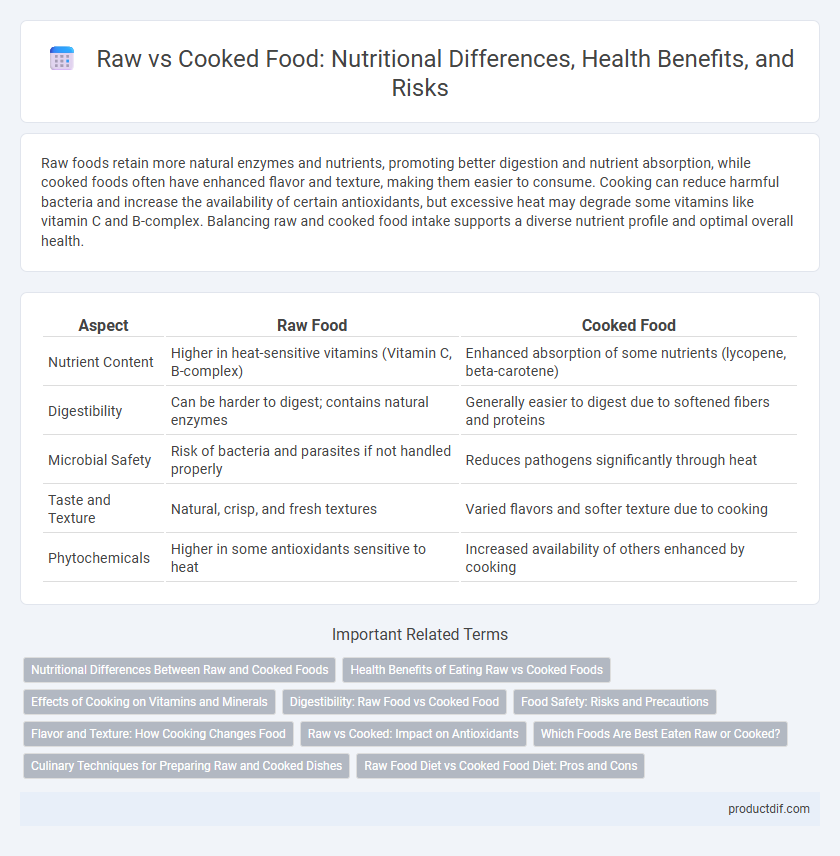Raw foods retain more natural enzymes and nutrients, promoting better digestion and nutrient absorption, while cooked foods often have enhanced flavor and texture, making them easier to consume. Cooking can reduce harmful bacteria and increase the availability of certain antioxidants, but excessive heat may degrade some vitamins like vitamin C and B-complex. Balancing raw and cooked food intake supports a diverse nutrient profile and optimal overall health.
Table of Comparison
| Aspect | Raw Food | Cooked Food |
|---|---|---|
| Nutrient Content | Higher in heat-sensitive vitamins (Vitamin C, B-complex) | Enhanced absorption of some nutrients (lycopene, beta-carotene) |
| Digestibility | Can be harder to digest; contains natural enzymes | Generally easier to digest due to softened fibers and proteins |
| Microbial Safety | Risk of bacteria and parasites if not handled properly | Reduces pathogens significantly through heat |
| Taste and Texture | Natural, crisp, and fresh textures | Varied flavors and softer texture due to cooking |
| Phytochemicals | Higher in some antioxidants sensitive to heat | Increased availability of others enhanced by cooking |
Nutritional Differences Between Raw and Cooked Foods
Cooking alters the nutritional profile of foods by breaking down cell walls, which can enhance the bioavailability of some nutrients like lycopene in tomatoes and beta-carotene in carrots, yet it can also lead to the loss of heat-sensitive vitamins such as vitamin C and certain B vitamins. Raw foods retain maximum levels of water-soluble vitamins and enzymes that may be degraded during cooking, supporting digestion and nutrient absorption. The balance between raw and cooked food consumption depends on specific dietary goals and the type of food being consumed for optimal nutrient retention.
Health Benefits of Eating Raw vs Cooked Foods
Eating raw foods preserves natural enzymes and vitamins such as vitamin C and folate, which can be diminished through cooking processes. Cooked foods often have enhanced bioavailability of certain nutrients like lycopene and beta-carotene, improving antioxidant absorption and digestion. Balancing raw and cooked food intake supports optimal nutrient diversity, gut health, and immune function.
Effects of Cooking on Vitamins and Minerals
Cooking often reduces the levels of heat-sensitive vitamins such as vitamin C and some B vitamins, leading to nutrient loss in raw vegetables. Minerals like potassium, calcium, and magnesium remain relatively stable but can leach into cooking water, decreasing their content if the liquid is discarded. Steaming or microwaving minimizes nutrient loss by preserving vitamins and retaining minerals better than boiling or frying.
Digestibility: Raw Food vs Cooked Food
Cooking food breaks down complex fibers and proteins, enhancing digestibility and nutrient absorption compared to raw food. Raw foods retain natural enzymes that aid digestion, but these enzymes are often deactivated during cooking, which can sometimes reduce digestive strain. Studies indicate that cooked vegetables improve nutrient bioavailability, while raw foods may be harder to digest for some individuals due to tougher cell walls.
Food Safety: Risks and Precautions
Raw foods, especially meats, seafood, and eggs, pose significant food safety risks due to potential contamination with harmful bacteria like Salmonella, E. coli, and Listeria. Cooking food to appropriate internal temperatures effectively kills these pathogens, reducing the risk of foodborne illness. Proper handling, storage, and avoiding cross-contamination are essential precautions to ensure raw and cooked foods remain safe for consumption.
Flavor and Texture: How Cooking Changes Food
Cooking transforms food by breaking down complex molecules, intensifying flavors and altering textures to enhance palatability. Raw foods often boast a crisp, natural texture and a more subtle, fresh taste, while cooking develops richer, deeper flavors and softens textures through processes like caramelization, Maillard reaction, and protein denaturation. These chemical changes create a sensory experience that raw food cannot replicate, balancing taste and mouthfeel according to culinary techniques.
Raw vs Cooked: Impact on Antioxidants
Raw foods often retain higher levels of antioxidants such as vitamin C, polyphenols, and flavonoids, which can be sensitive to heat and degrade during cooking. However, cooking methods like steaming or microwaving can preserve or even enhance the bioavailability of certain antioxidants like lycopene in tomatoes and beta-carotene in carrots. The antioxidant capacity in cooked foods depends on factors including temperature, cooking time, and the specific nutrient profile of the food.
Which Foods Are Best Eaten Raw or Cooked?
Leafy greens like spinach and kale retain more vitamins and antioxidants when eaten raw, while root vegetables such as carrots and potatoes benefit from cooking to enhance nutrient absorption and digestibility. Tomatoes provide higher levels of bioavailable lycopene when cooked, whereas fruits such as apples and berries are most beneficial consumed raw to preserve their vitamin C content. Cruciferous vegetables like broccoli and cauliflower release more cancer-fighting compounds when steamed lightly but may lose nutrients if overcooked.
Culinary Techniques for Preparing Raw and Cooked Dishes
Culinary techniques for preparing raw dishes include methods like marinating, curing, and pickling that enhance flavor while preserving texture and nutrients. Cooked dishes often utilize techniques such as steaming, roasting, grilling, and sauteing to develop complex flavors, tenderize proteins, and improve digestibility. Mastering these cooking methods allows chefs to balance taste, texture, and nutritional value in both raw and cooked food preparations.
Raw Food Diet vs Cooked Food Diet: Pros and Cons
The raw food diet emphasizes consuming uncooked, unprocessed foods to preserve natural enzymes and nutrients, potentially enhancing digestion and energy levels, but it may lack sufficient protein and certain bioavailable nutrients. Cooked food diets improve nutrient absorption, especially for compounds like lycopene and beta-carotene, and reduce foodborne pathogens, yet some vitamins, such as vitamin C, are diminished during cooking. Balancing raw and cooked food intake can optimize nutrient diversity, digestive health, and overall metabolism.
raw vs cooked Infographic

 productdif.com
productdif.com